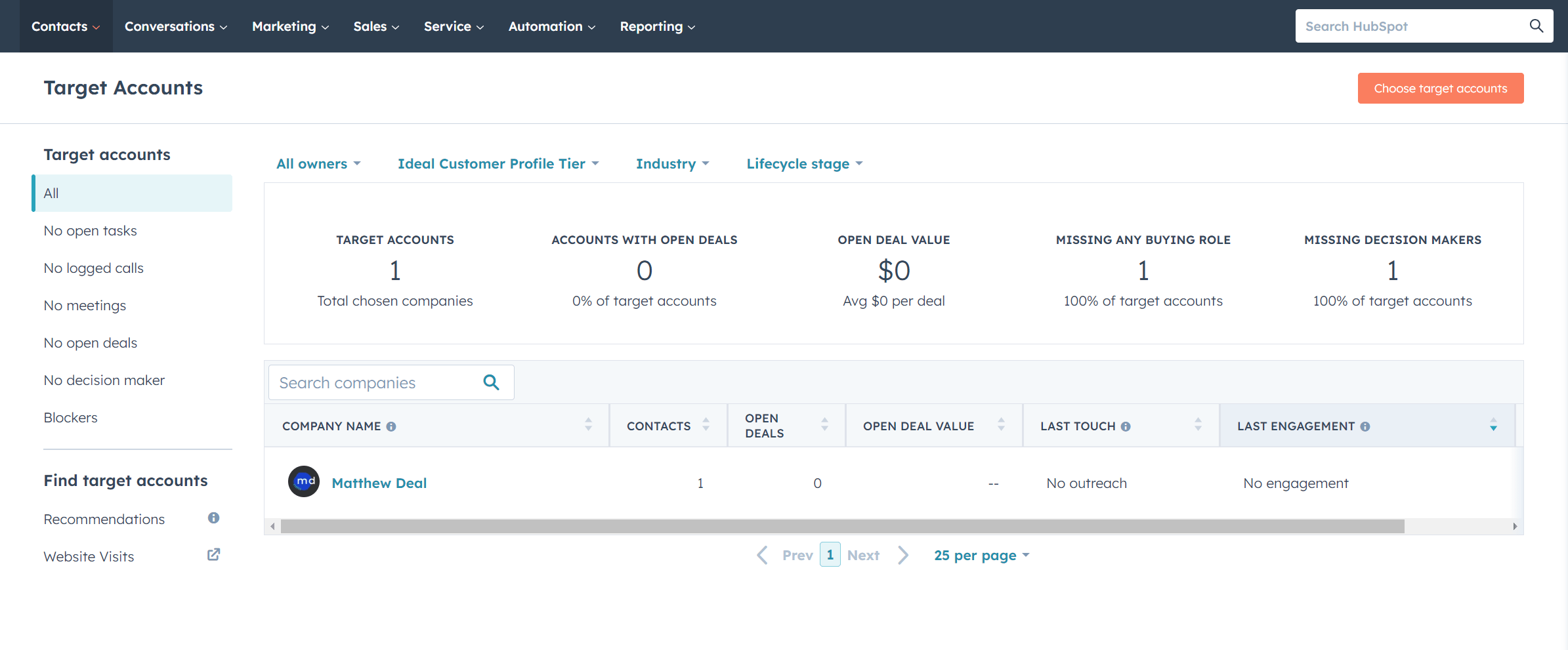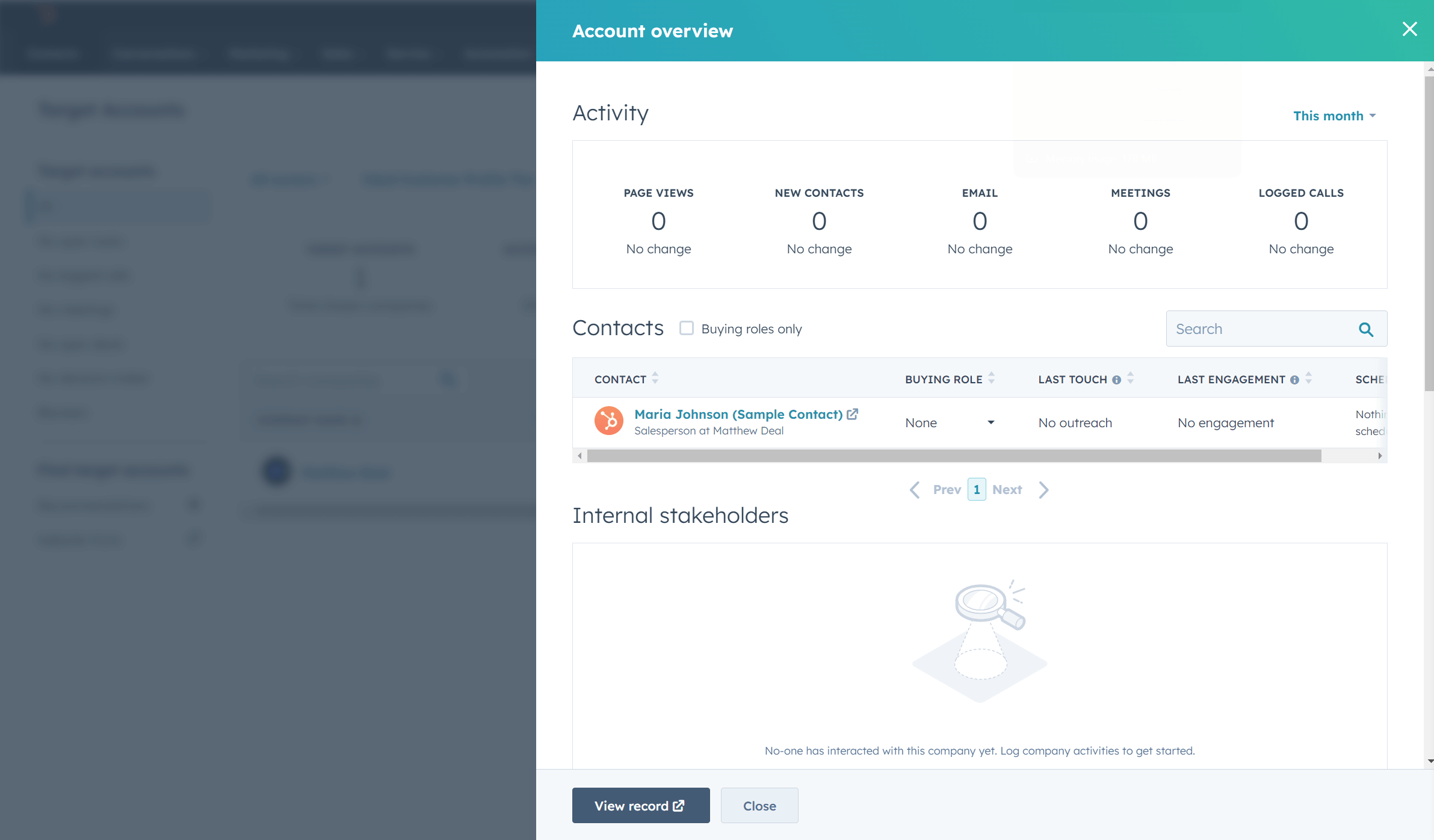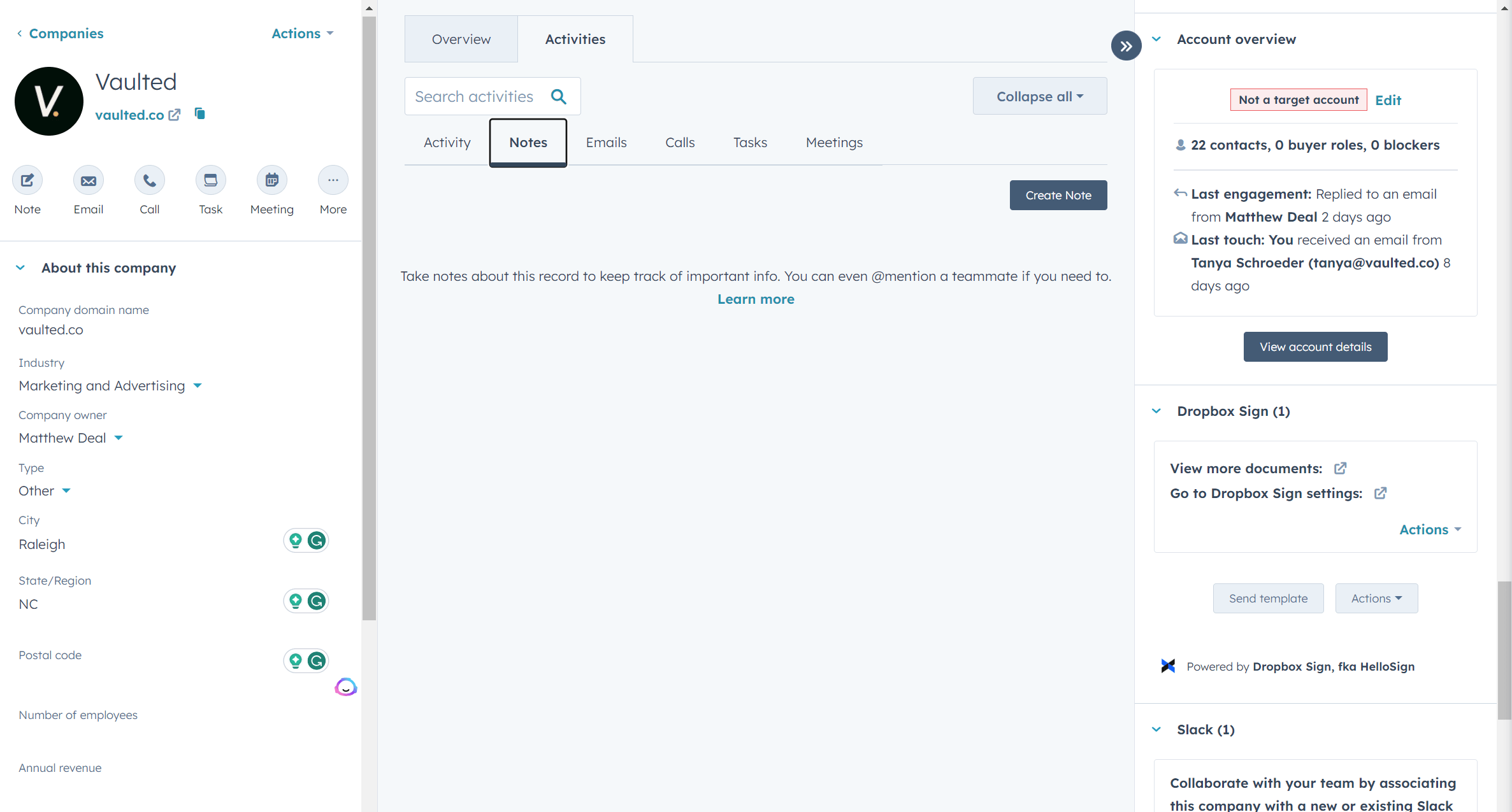HubSpot Target Accounts: Maximizing B2B Sales
Mastering the sales arena in today's market means zeroing in on high-value accounts. HubSpot's Target Accounts feature is designed precisely for this purpose. Aligning perfectly with the intricate demands of Account-Based Marketing (ABM), it stands as an indispensable tool for sales teams.
HubSpot Target Accounts offer a wealth of detailed analytics, effortless integration, and extensive customization, thereby redefining the approach to personalized and strategic sales initiatives. In addition, the data from the feature helps marketing teams and sales teams work together to better understand who they are targeting.
In our comprehensive overview of HubSpot Target Accounts, we'll demonstrate how it transforms B2B sales, focusing on its features and real-world applications for boosting sales strategies.
Read on to learn how you can use Target Accounts to streamline your sales process!
Demystifying Account-Based Marketing
At its core, Account-Based Marketing (ABM) is about focusing your efforts on a select group of high-value accounts within the market. This strategy involves crafting personalized campaigns designed to resonate with each account, treating them as unique markets in their own right.
The approach allows for a more in-depth understanding of each client's specific business environment, leading to sharper targeting and the development of content that hits the mark every time. In the B2B realm, the power of ABM is undeniable. It zeroes in on key decision-makers within chosen accounts, thereby elevating conversion rates and boosting return on investment (ROI).
ABM's strength lies in its ability to create bespoke content and communication strategies for each account, deepening customer engagement and cementing stronger relationships with prospects. It also harmonizes marketing and sales strategies, enhancing overall efficiency and effectiveness.
Empirical research backs the efficacy of ABM. A noteworthy benchmark study revealed that a significant 72% of participants found ABM to be more ROI-effective compared to other marketing strategies. Additionally, 66% acknowledged the vital role ABM plays in reinforcing the collaboration between marketing and sales teams. These findings highlight ABM's critical role in shaping modern marketing strategies.
By leveraging ABM, you can ensure that your sales and marketing teams can work together. That way, you can get more high quality leads and nurture them at every level of the marketing funnel.
HubSpot & ABM: A Synergistic Approach to B2B Marketing
HubSpot excels in unifying sales and marketing CRM functionalities, offering a cohesive perspective on the buyer's journey. This integration of sales and marketing is pivotal for streamlining team collaboration and fostering business growth.
With the Target Accounts feature, HubSpot takes your ABM strategies to new heights, ensuring consistent communication and delivering a unified experience for prospects, essential for crafting effective ABM strategies.
Initiating HubSpot's ABM Tools: A Practical Guide
To begin using HubSpot's ABM tools, your administrator must enable the feature.

Note: This action requires Super admin or specific account access permissions and is irreversible once activated.
For optimal use of Target Accounts and other ABM features, follow these steps:
- Log into your HubSpot account and go to Contacts > Target Accounts.
- Click on "Get Started" to initiate your Target Accounts index page setup.
Once you’re here, you need to configure your account, and we break down how to do that in the next section.
Configuring Target Accounts in HubSpot
There are several methods to set target accounts in HubSpot. At Vaulted, we turn to these two frequently used techniques:
Method 1: Direct Company Assignment
This method is Ideal for when you have a specific company in mind for targeting. To get started, follow the following steps:
- Go to the desired company’s profile.
- In the Account Overview Card, select 'Edit' and set the Target Account to "True," then apply.
By following these steps, you update the account’s status and provides an overview of associated contacts and recent engagements.
Method 2: Utilizing the Target Accounts Index Page
This method is effective for browsing and selecting from your CRM database. To get started, follow these steps:
- Visit the Target Accounts index page.
- Select 'Choose Target Accounts' to view all companies.
- Choose your target companies and save your selections.
This strategic process focuses on the quality, not quantity, of target accounts, encouraging a more thoughtful selection process.

Depending on your team and your needs, you can choose one of the two methods above. If you need overall status and engagements, Method 1 is a good choice. If you want to choose targets more thoughtfully and want more of a custom view, Method 2 is a solid choice for your needs.
Whatever you choose, this is the first step to setting Target Accounts and using them for better data for sales and marketing alike.
Additional HubSpot ABM Data Points
Once you set up and a company is designated as a Target Account, HubSpot prompts for two more data points:
- Ideal Customer Profile Tier: This system categorizes companies into three tiers based on how closely they match your ideal customer profile.
- Buyer Role: This feature clarifies the role of each contact within the decision-making hierarchy, with categories like 'Decision Maker', 'Influencer', 'Champion', and 'Blocker'.
Identifying these roles allows for more tailored communication strategies, aligning with each contact's unique position in their organization’s decision-making process. This nuanced approach is key to crafting impactful and persuasive messages that resonate with each stakeholder.
Going through these ABM data points allows you to put more specialized attention into your more high value leads and get more data for your sales and marketing teams.
Optimizing ABM with HubSpot’s Target Accounts Index Screen
The HubSpot Target Accounts Index Screen is an indispensable part of your ABM arsenal. It offers a straightforward, tabular view of your target accounts, providing high-level insights into crucial aspects like contacts, ongoing deals, recent interactions, and last engagements.
This screen serves as your central hub for a quick, data-driven overview of your account status, allowing you to make well-informed decisions efficiently. It’s designed to simplify monitoring your ABM activities, offering a comprehensive snapshot at a glance.
While the Target Accounts Index Screen includes essential filters like Lifecycle Stage, Owner, and Industry, it's worth noting it doesn't encompass the entire range of HubSpot’s filtering capabilities.
At Vaulted, we recognize this as a limitation, as additional filters could further refine account management. However, this design decision by HubSpot likely aims to maintain simplicity and user-friendliness.
Delving Deeper with the Account Overview Screen
The Account Overview Screen in HubSpot’s ABM suite provides a detailed view of each target account. It aggregates all pertinent data, offering a holistic picture vital for strategic decision-making.

This screen displays critical information about contacts, tracks active and closed deals, and monitors related tasks. Additionally, it provides insights into user behaviors, such as page views and email interactions. This centralization of data simplifies account management, ensuring access to the most current and relevant information for each account.
Using this data, you can start thinking about your ABM strategy and how to effectively nurture these accounts. As we move forward in this guide, we’ll go beyond the basics and how to use this screen to make the most out of your sales and marketing efforts.
Crafting a Cohesive ABM Strategy in HubSpot
Your ABM strategy in HubSpot revolves around three key elements: Target Accounts, Buyer Roles, and the Ideal Customer Profile (ICP) Tier. Here is how each of these elements break down:
- Target Accounts: These identify high-value prospects for tailored engagement and nurturing.
- Buyer Roles: This aspect shapes your messaging to align with the decision-making framework of each account, enhancing the impact of your communications.
- ICP Tier: This feature helps in prioritizing engagement efforts by categorizing companies based on their fit with your ideal customer profile.
Together, these components form a comprehensive, nuanced ABM strategy. They contribute to a more targeted, personalized approach, enhancing both the precision and effectiveness of your ABM initiatives.
Once you get familiar which each of these elements, you can start building strategies to engage leads that are on these lists. At Vaulted, we like to pay close attention to these parts of ABM in HubSpot to build out strategies for our clientele.
Leveraging HubSpot's ABM Tools for Enhanced Marketing and Sales Impact
Having set up the foundational data within HubSpot for ABM strategies, it’s vital to understand that simply tagging an account as a Target Account doesn’t automatically initiate any specific actions.

This designation serves as a crucial data point, a springboard for utilizing HubSpot’s sales and marketing tools more effectively. Next we’ll dig into the practical application of HubSpot’s ABM tools, exploring how they can be used to actively engage and communicate with high-value prospects.
Below, we go over how to use ABM lists in HubSpot across sales and marketing. We also offer examples about how Target Accounts benefits marketers and sales team members using them.
Sales: Strategic Prospecting with ABM Lists
One of the most powerful features for sales teams in HubSpot is the ability to create targeted prospecting lists. These lists are instrumental in segmenting data to focus on specific groups, enhancing the effectiveness of sales outreach.
For example, if you’re targeting financial firms, HubSpot’s lists enable you to direct outbound emails or sequences to specific buyer roles within these organizations. This level of customization ensures your messages are tailored to address the unique challenges and interests of each segment, enhancing the personalization of your outreach and strengthening your connection with potential clients.
Marketing: ABM in Social Media Engagement
In the realm of marketing, ABM can significantly elevate your social media strategies, especially on platforms like LinkedIn. By segmenting data in HubSpot, you can pinpoint potential attendees for events or webinars, moving beyond basic targeting to a more integrated approach.
This could involve targeting professionals in the software industry through LinkedIn’s ad tools, ensuring that your content is not only seen but also resonates with the right audience, thereby increasing the chances of successful lead generation and conversion.
Marketing and Sales: Streamlining with Workflow Automation
HubSpot shines in automating workflows, especially in aspects like lead assignment and notifications. When a Target Account is marked in HubSpot, the system can auto-assign it to the most appropriate team member.
For instance, if a tech firm is identified as a Target Account, it’s instantly assigned to a team member specializing in that sector, who then receives an alert for immediate action.
This seamless integration of lead assignment and notifications guarantees that each Target Account is given prompt and personalized attention, enhancing the efficiency of both sales and marketing efforts.
Sales: Tailored Outreach with Precision Targeting
HubSpot’s ABM tools equip sales teams with precision targeting capabilities. By creating specific prospecting lists, sales reps can cater their outreach to various professional roles and industries.
For example, sales reps can target healthcare professionals with customized sequences, addressing industry-specific challenges and needs. This personalized approach not only enhances the likelihood of engagement but also increases the overall effectiveness of communication, leading to more meaningful interactions and potential conversions.
Marketing: Boosting Engagement with Lead Scoring and Alerts
HubSpot’s lead scoring system, paired with automated alerts, is a critical component of effective marketing. It allows teams to track engagement levels and identify leads showing strong buying signals.
When a lead reaches a specific score threshold, the system automatically alerts the sales team, enabling them to reach out with relevant, personalized communication. This strategic use of lead scoring and alerts harmonizes marketing efforts with sales opportunities, facilitating a streamlined process for nurturing and converting high-value leads.
Sales and Marketing: Analytics and Data: Driving Informed Decisions and Strategy
HubSpot's ABM tools are integral for providing crucial analytics and data for informed decision-making and strategic planning. This integration facilitates seamless tracking of customer interactions, offering valuable insights for nurturing enduring relationships with key accounts.
For example, with the Account Overview Screen, a marketer can look at customer interactions across different channels to see where they are in the marketing funnel. This allows sales and marketing to work together on building strategies about what type of content needs to be pushed out and if any outreach is necessary. Taking the analytics and customer insights into account, they can make smarter decisions that support the bottom line.
Measuring Success and ROI in ABM Efforts
Precise campaign tracking and sales sequence performance analysis in HubSpot are essential for measuring ABM success and ROI. This approach ensures alignment with business goals and helps in continuously refining strategies.
For example, when a sales person uses data from the Account Overview Screen on Target Accounts, they can take a look at the status of the lead, user behavior, and related tasks. Taking the big picture into consideration, they can measure it against their goals and overall ROI of sales strategies. Because HubSpot has comprehensive analytics and tracking on this feature, team members can build upon their ABM strategy to meet their sales goals.
Preparing for the Future: Anticipating ABM Trends with Advanced Technologies
The future of ABM will be shaped by AI Analytics, Intent Data, Anonymous Visitor Identification, and Predictive Lead Scoring. These advancements will enable more innovative and effective engagement with target accounts, ensuring businesses stay ahead in the B2B landscape.
Ultimately, HubSpot's ABM tools offer a robust and comprehensive solution for engaging effectively with target accounts. Utilizing the power of analytics, the insights of predictive technologies, and the customization offered by tailored strategies, these tools empower businesses to significantly elevate their B2B sales and marketing endeavors.
Embracing the advanced capabilities of HubSpot for ABM positions businesses for greater growth and a competitive advantage in the ever-evolving B2B marketplace.
How Vaulted Can Help You Optimize Your ABM Strategies
We hope this guide has helped show the value of ABM and using the Target Accounts feature in HubSpot. While this is very technical, utilizing the feature will help you better nurture your leads and grow sales for your business.
Of course, even with this guide, using ABM strategies like this can be overwhelming. As always, if you need help with Target Accounts or setting up your HubSpot account for success in other ways, we’re happy to help.
Vaulted specializes in optimizing ABM strategies and aligning sales and marketing efforts for effective revenue operations. Our expertise in utilizing HubSpot's ABM tools enables us to tailor strategies to each company's unique needs, focusing on:
- Designing resonant ABM campaigns that align with target accounts.
- Creating synergies between sales and marketing for unified, goal-oriented strategies.
- Integrating ABM strategies with overall business objectives to drive growth and ROI.
Partnering with Vaulted means leveraging our expertise in ABM and HubSpot to achieve superior results in your B2B engagements. If you’re ready to get started, reach out to our team and let us know what you’re currently struggling with. We're here to help you navigate the complexities of digital marketing so you can focus on what you do best—growing your business.
Elevate Your ABM Strategy
Ready to harness the full potential of HubSpot's Target Accounts for your business?
Search by Tags
Be the First to
Know Subscribe to Our Newsletter!
Discover More Insights

Using HubSpot Like a Flip Phone? A Development Agency Can Fix That
. You know that feeling when you buy a fancy new phone, but all you use it for is texting and the occasional phone call? That’s what it’s like for some businesses using HubSpot. They invest in the platform packed with powerful tools and end up using just a sliver of what it can actually do. They sign up, poke around a bit, maybe send a newsletter or two, but never really unlock its full potential.

Search Engine Optimization Durham: Unlocking Organic Growth for Your Business
If you’ve ever watched another box truck lose its roof to Durham’s infamous “Can Opener” bridge, you know one thing: a small miscalculation can cost you big. The same goes for modern search engine optimization—especially now that AI results and GEO surfaces can shear off the traffic you once took for granted.

 Emily Davidson
Emily Davidson

 Jordan Parker
Jordan Parker